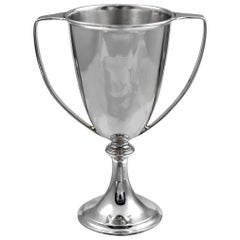Tiffany Loving Cup
Recent Sales
Vintage 1910s American More Silver, Flatware and Silverplate
Sterling Silver
Tiffany & Co. for sale on 1stDibs
Tiffany & Co. is one of the most prominent purveyors of luxury goods in the United States, and has long been an important arbiter of style in the design of diamond engagement rings. A young Franklin Delano Roosevelt proposed to his future wife, Eleanor, with a Tiffany ring in 1904. Vanderbilts, Whitneys, Astors and members of the Russian imperial family all wore Tiffany & Co. jewels. And Jacqueline Kennedy Onassis preferred Tiffany china for state dinners at the White House.
Although synonymous with luxury today, the firm started out rather modestly. Charles Lewis Tiffany and John B. Young founded it in Connecticut as a “stationery and fancy goods emporium” in 1837, at a time when European imports still dominated the nascent American luxury market. In 1853, Charles Tiffany — who in 1845 had launched the company’s famed catalog, the Blue Book, and with it, the firm’s signature robin’s-egg blue, which he chose for the cover — shifted the focus to fine jewelry. In 1868, Tiffany & Co. gained international recognition when it became the first U.S. firm to win an award for excellence in silverware at the Exposition Universelle in Paris. From then on, it belonged to the pantheon of American luxury brands.
At the start of the Gilded Age, in 1870, Tiffany & Co. opened its flagship store, described as a "palace of jewels" by the New York Times, at 15 Union Square West in Manhattan. Throughout this period, its designs for silver tableware, ceremonial silver, flatware and jewelry were highly sought-after indicators of status and taste. They also won the firm numerous accolades, including the grand prize for silverware at the Paris Exposition of 1878. Among the firm’s glittering creations from this time are masterworks of Art Nouveau jewelry, such as this delicate aquamarine necklace and this lavish plique-à-jour peridot and gold necklace, both circa 1900.
When Charles Lewis Tiffany died, in 1902, his son Louis Comfort Tiffany became the firm’s design director. Under his leadership, the Tiffany silver studio was a de facto design school for apprentice silversmiths, who worked alongside head artisan Edward C. Moore. The firm produced distinctive objects inspired by Japanese art and design, North American plants and flowers, and Native American patterns and crafts, adding aesthetic diversity to Tiffany & Co.’s distinguished repertoire.
Tiffany is also closely associated with diamonds, even lending its name to one particularly rare and exceptional yellow stone. The firm bought the Tiffany diamond in its raw state from the Kimberley mines of South Africa in 1878. Cut to create a 128.54-carat gem with an unprecedented 82 facets, it is one of the most spectacular examples of a yellow diamond in the world. In a broader sense, Tiffany & Co. helped put diamonds on the map in 1886 by introducing the American marketplace to the solitaire diamond design, which is still among the most popular engagement-ring styles. The trademark Tiffany® Setting raises the stone above the band on six prongs, allowing its facets to catch the light. A lovely recent example is this circa-2000 platinum engagement ring. Displaying a different design and aesthetic (but equally chic) is this exquisite diamond and ruby ring from the 1930s.
Finding the Right silver-flatware-silverplate for You
While early utensils were often shaped from clay, wood or bone, silversmiths later crafted flatware from precious metal. In the 19th century, mass production of electroplated flatware made silver utensils accessible to the middle class. Now, antique and vintage silver, flatware and silver-plate objects for dining and the home are heritage pieces reflecting this history of design.
Silver spoons were so prized in 15th-century England that people would travel with the valuable utensils. Forks in the 17th century were frequently made with steel and likewise only available to the upper class. Silver flatware continued to be produced in small workshops in the 18th century and was a luxury reserved for the elite. When George I came to the throne in 1714, the silver dining service — including plates, dishes, soup tureens, chargers and sauceboats — became all-important.
Innovative manufacturing techniques such as the electroplating process in the 19th century would transform silversmithing with industrialization. Sheffield plate was used from 1750 to 1880 and involved a fusion method to fabricate everything from knife handles to serveware. French industrial chemist Henri de Ruolz discovered a gilding and silver-plating process for metals in 1841, with the silver-like results so celebrated that Napoleon III ordered a 3,000-piece flatware set. The expansion of table service in the Victorian era also led to an increasing number of flatware and serving pieces in a canteen, or cutlery chest, all with specific uses, from toast forks to butter picks.
While affordable metal flatware is widely available today, historic brands including Gorham Manufacturing Company — whose legendary contribution to the history of silver making started in 1831 — and Christofle continue the tradition of silver and silver-plate flatware.
Browse 1stDibs for both antique and contemporary silver, flatware and silver-plate objects in a range of elegant designs to enhance your dining table.
- 1stDibs ExpertAugust 17, 2021A Tiffany & Co. engagement ring can cost as little as $13,000 or as much as $500,000 depending on the center stone’s carat weight, the band material and whether or not there are any side stones. The smaller the stone, the cheaper the ring will be. Find engagement rings designed by Tiffany & Co. on 1stDibs.
